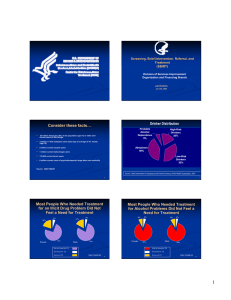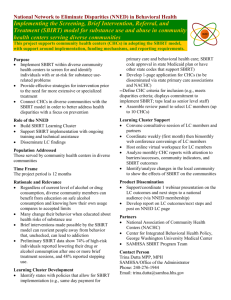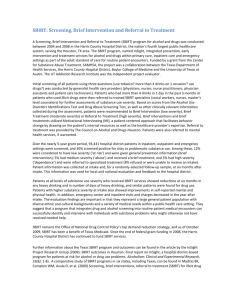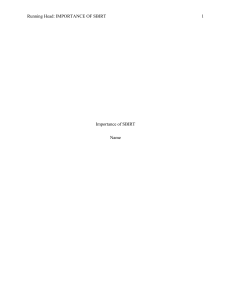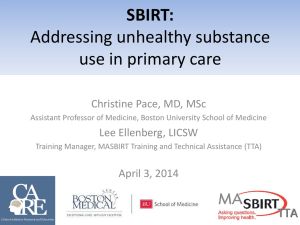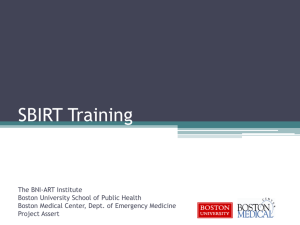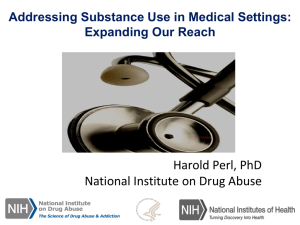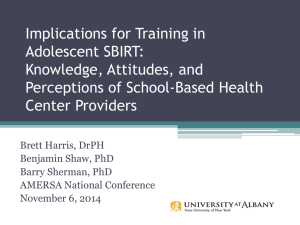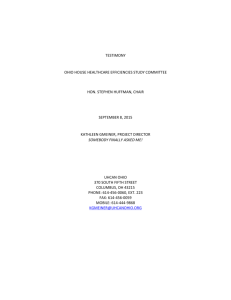Motivational Enhancement & Engagement Strategies
advertisement
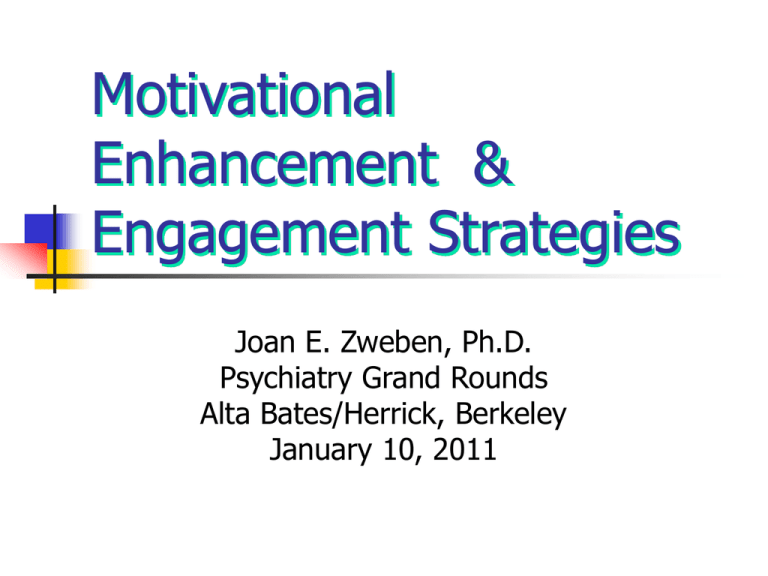
Motivational Enhancement & Engagement Strategies Joan E. Zweben, Ph.D. Psychiatry Grand Rounds Alta Bates/Herrick, Berkeley January 10, 2011 Different Levels of Severity (ONDCP - 2010) LOTS In Treatment ~ 2,300,000 Addiction ~~24,000,000 25,000,000 Diabetes (Focus on Treatment) “Harmful Use:” – 68,000,000 (focus on Early Intervention) LITTLE Little or No Use (focus on Prevention) Screening, Brief Intervention & Referral to Treatment (SBIRT) SBIRT is a comprehensive, integrated, public health approach to the delivery of early intervention and treatment services for persons with SUDS, as well as those who are at risk of developing these disorders. Primary care centers, hospital emergency rooms, trauma centers, and other community settings provide opportunities for early intervention with at-risk substance users before more severe consequences occur SBIRT Activities Screening quickly assesses the severity of substance use and identifies the appropriate level of treatment. Brief intervention focuses on increasing insight and awareness regarding substance use and motivation toward behavioral change. Referral to treatment provides those identified as needing more extensive treatment with access to speciality care. (http://sbirt.samhsa.gov) Is SBIRT Effective? SBIRT research has shown that large numbers of individuals at risk may be identified through primary care screening. Interventions such as SBIRT have been found to: Decrease the frequency and severity of drug and alcohol use, Reduce the risk of trauma, and Increase the percentage of patients who enter specialized substance abuse treatment. Screening and brief interventions have also been associated with fewer hospital days and fewer emergency department visits. Cost-benefit analyses and cost-effectiveness analyses have demonstrated net-cost savings from these interventions. History & Current Context 1992 – In Search of How People Change (Prochaska, DiClemente & Norcross) CSAT provided training and developed materials Growing recognition that untreated substance abuse is expensive: physical and mental health, social services and criminal justice systems History & Current Context patients referred from other services with insufficient attention to motivation no specific arena to address ambivalence “Wait until they are ready” AOD programs: discharge for noncompliance with high expectations discovery that untreated substance abuse is expensive Treatment Outcome Findings retention improves outcome enduring gains often require at least 6 months of treatment addiction treatment works as well as treatment for other chronic relapsing disorders (asthma, diabetes, hypertension) patient implementation of treatment recommendations is the key Getting Motivated: Accumulating Consequences increasing dysphoria, emotional distress loss of important relationship(s) loss of job; interference with performance health problems financial problems legal problems Enticements: Severely Mentally Ill help in obtaining food, housing access to entitlement programs help in avoiding legal penalties socialization, recreation, vocational opportunities relief from distressing symptoms Harm Reduction Valuable approach that produces public health benefits Permits low threshold place to begin addressing AOD using behavior Many pitfalls for the clinician Clinician can make forthright recommendations and still work with patient’s goals Negotiating an Abstinence Commitment Connect AOD use with presenting complaints facilitate progress through initial decision making phases of change blend careful inquiry, giving information, gentle confrontation experiment with abstinence; sobriety sampling enhance motivation, vs punish ambivalence Reasons to Resist an Abstinence Commitment fear of failure addiction pattern in family of origin self medication trauma history survivor guilt Motivational Enhancement Strategies TIP 35 Enhancing Motivation for Change in Substance Abuse Treatment Goals and Benefits Inspiring motivation to change Preparing clients to enter treatment Engaging and retaining clients in treatment Increasing participation and involvement Improving treatment outcomes Encouraging a rapid return to treatment if symptoms recur Stages of Change Precontemplation Contemplation Preparation Action Maintenance Motivational Interviewing Principles expression of empathy development of discrepancy avoidance of argumentation rolling with resistance supporting self-efficacy Basic Interventions Develop discrepancy between client’s goals or values and their current behavior Avoid argument and direct confrontation; roll with resistance Express empathy through reflective listening Adjust to client resistance rather than opposing it directly Support self-sufficiency; self-efficacy and optimism Eliciting Self-Motivating Statements Ask evocative questions In what way has drinking been a problem for you? In what ways does it concern you? Explore pros and cons Ask for elaboration Imagining extremes If you don’t stop drinking/using, what is the worst thing that could happen Eliciting Self-Motivating Statements, Continued Looking forward Think ahead 5 years, what would you like your life to be like? How does what you are doing now fit into that? What would it take for you to decide, “I have to do something?” Looking back When was the last time things were going well and what was your life like then? Opening Strategies Ask open-ended questions Listen reflectively Summarize periodically Affirm: comment on client resources, strengths, positive behaviors Elicit self-motivational statements; reinforce positive expressions FRAMES Approach Feedback about risk/impairment is given following assessment Responsibility placed on client Advice given clearly in nonjudgmental manner Menu of options/alternatives is offered Self-efficacy or optimistic empowerment is promoted to encourage change Precontemplation Stage Task is to raise awareness Offer factual information Explore events that brought the person in and the results of previous efforts Explore pros and cons of drinking/using (Jeanne L. Obert, MFT, Matrix Institute, Los Angeles) Contemplation Stage Taks is to resolve ambivalence about change and help client choose change What does the client think the change will entail? Level of self-efficacy and expectations Continue exploration of pros and cons Summarize self-motivational statements (Jeanne L. Obert, MFT, Matrix Institute, Los Angeles) Action Stage Task: select and implement change strategies; address relapse hazards Discuss and select change strategies Enlist social and family support Identify high-risk situations and develop coping strategies Find new reinforcers of positive change (Jeanne L. Obert, MFT, Matrix Institute, Los Angeles) Maintenance Stage Task: develop new skills for maintaining recovery Identify and try alternative behavior (stress management, enjoyment) Develop an escape plan for high risk situations Set new short and long term goals (Jeanne L. Obert, MFT, Matrix Institute, Los Angeles) References Miller, W. R. (1999). Enhancing Motivation for Change in Substance Abuse Treatment (Vol. 35). Rockville, Maryland: U.S. Department of Health and Human Services. Prochaska, J. O., DiClemente, C. C., & Norcross, J. C. (1992). In Search of How People Change: Applications to addictive behaviors. American Psychologist, 47, 1102-1114. Washton, A., & Zweben, J. E. (2009). Cocaine & Methamphetamine Addiction: Treatment, Recovery, and Relapse Prevention. New York: W.W. Norton. Washton, A. M., & Zweben, J. E. (2006). Treating Alcohol and Drug Problems in Psychotherapy Practice: Doing What Works. New York: Guilford Press. Resources Addiction Technology Transfer Centers: www.nattc.org Center on Alcoholism, Substance Abuse & Addictions: http://casaa.unm.edu/ NIDA Blending Initiative – partnership with SAMHSA to disseminate research findings: www.nida.nih.gov/Blending/ NIDA Dissemination Library: http://ctndisseminationlibrary.org/ Download slides from: www.ebcrp.org

